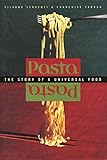Pasta : The Story of a Universal Food / Silvano Serventi, Françoise Sabban.
Material type: TextSeries: Arts and Traditions of the Table: Perspectives on Culinary HistoryPublisher: New York, NY : Columbia University Press, [2002]Copyright date: ©2002Description: 1 online resource (416 p.) : 30 illusContent type:
TextSeries: Arts and Traditions of the Table: Perspectives on Culinary HistoryPublisher: New York, NY : Columbia University Press, [2002]Copyright date: ©2002Description: 1 online resource (416 p.) : 30 illusContent type: - 9780231124423
- 9780231519441
- 641.8/22 22
- online - DeGruyter
- Issued also in print.
| Item type | Current library | Call number | URL | Status | Notes | Barcode | |
|---|---|---|---|---|---|---|---|
 eBook
eBook
|
Biblioteca "Angelicum" Pont. Univ. S.Tommaso d'Aquino Nuvola online | online - DeGruyter (Browse shelf(Opens below)) | Online access | Not for loan (Accesso limitato) | Accesso per gli utenti autorizzati / Access for authorized users | (dgr)9780231519441 |
Browsing Biblioteca "Angelicum" Pont. Univ. S.Tommaso d'Aquino shelves, Shelving location: Nuvola online Close shelf browser (Hides shelf browser)

|

|

|

|

|

|

|
||
| online - DeGruyter When Did the Statue of Liberty Turn Green? : And 101 Other Questions About New York City / | online - DeGruyter Tamil Oratory and the Dravidian Aesthetic : Democratic Practice in South India / | online - DeGruyter Factory of Strategy : Thirty-Three Lessons on Lenin / | online - DeGruyter Pasta : The Story of a Universal Food / | online - DeGruyter The Islamic Context of The Thousand and One Nights / | online - DeGruyter On Civic Friendship : Including Women in the State / | online - DeGruyter Global Population : History, Geopolitics, and Life on Earth / |
Frontmatter -- Contents -- Series Editor's Preface -- Preface -- Note Concerning a Definition of Pasta Products -- Acknowledgments -- Introduction -- 1. The Infancy of an Art -- 2. The Time of the Pioneers -- 3. From the Hand to the Extrusion Press -- 4. The Golden Age of the Pasta Manufactory -- 5. The Industrial Age -- 6. Pasta Without Borders -- 7. The Time of Plenty -- 8. The Taste for Pasta -- 9. China: Pasta's Other Homeland -- 10. The Words of Pasta -- Notes -- Bibliography -- Index
restricted access online access with authorization star
http://purl.org/coar/access_right/c_16ec
Ranging from the imperial palaces of ancient China and the bakeries of fourteenth-century Genoa and Naples all the way to the restaurant kitchens of today, Pasta tells a story that will forever change the way you look at your next plate of vermicelli. Pasta has become a ubiquitous food, present in regional diets around the world and available in a host of shapes, sizes, textures, and tastes. Yet, although it has become a mass-produced commodity, it remains uniquely adaptable to innumerable recipes and individual creativity. Pasta: The Story of a Universal Food shows that this enormously popular food has resulted from of a lengthy process of cultural construction and widely diverse knowledge, skills, and techniques.Many myths are intertwined with the history of pasta, particularly the idea that Marco Polo brought pasta back from China and introduced it to Europe. That story, concocted in the early twentieth century by the trade magazine Macaroni Journal, is just one of many fictions umasked here. The true homelands of pasta have been China and Italy. Each gave rise to different but complementary culinary traditions that have spread throughout the world. From China has come pasta made with soft wheat flour, often served in broth with fresh vegetables, finely sliced meat, or chunks of fish or shellfish. Pastasciutta, the Italian style of pasta, is generally made with durum wheat semolina and presented in thick, tomato-based sauces. The history of these traditions, told here in fascinating detail, is interwoven with the legacies of expanding and contracting empires, the growth of mercantilist guilds and mass industrialization, and the rise of food as an art form. Whether you are interested in the origins of lasagna, the strange genesis of the Chinese pasta bing or the mystique of the most magnificent pasta of all, the timballo, this is the book for you. So dig in!
Issued also in print.
Mode of access: Internet via World Wide Web.
In English.
Description based on online resource; title from PDF title page (publisher's Web site, viewed 02. Mrz 2022)


